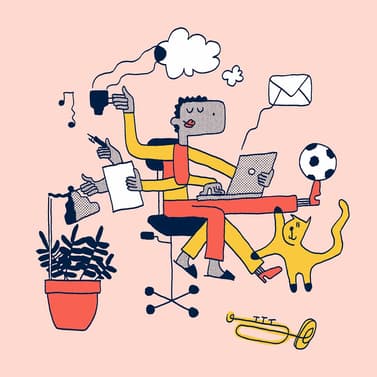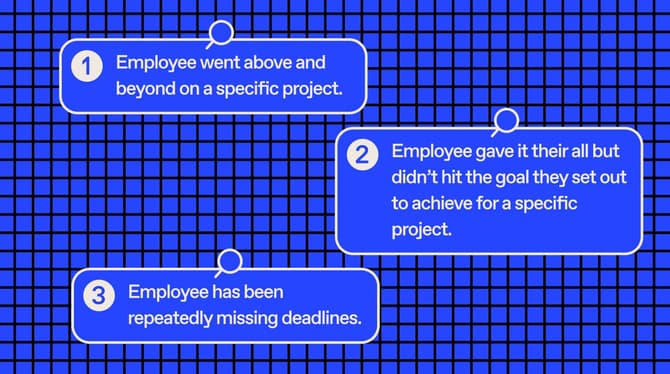DATA REPORT
What the trends of the last two years can tell us about the current state of employee experience and the future of how leaders and companies can shape it.
But first, what is employee experience (EX)?
Employee experience is any interaction with the company that shapes your experience, from how you interact with your manager and team, to your health and well-being, to working via digital technology.
EX is not a process or a project but a cross-functional strategy that needs to be embraced by the C-suite and recognized on the employee level. It encompasses employee experience strategies, practices, processes, systems, services, and technologies.
It’s broader than employee engagement and includes retention, health, productivity, leadership, and trust.
Exclusive online summit
·
May 23 2024
Moments that matter: how to seed great work
What's in this article
- But first, what is employee experience (EX)?
- Executive summary
- Context from an employee experience expert
- For the inquisitive bunch – A note on methodology
- Topline insights
- The Great Resignation: Who’s leaving and why?
- Distributed work: Home is where the office is
- Work-life balance synergy
- The ROI of exceptional EX
- Final thoughts
Executive summary
(This is a shortened version of The State of Employee Experience. Download the complete report for all the data and insights.)
Officevibe’s employee experience platform captures employee feedback from over 440 000 employees every week. With this data, we have the privilege of knowing what employees from 72 countries worldwide feel, need from, and think of their day-to-day experience at work — and this gives unique insights into how both EX is doing today and how employee expectations are shifting for our future.
It is an honor to have this inside view, and with that comes the important responsibility to respect user anonymity which we to in the highest standards. We also feel it is our responsibility to use these insights wisely by guiding leaders of today and tomorrow to adapt to this ever-changing work reality.
With this in mind, our in-house team of expert researchers pored over findings of the last two years to trace what employee experience looks like today and lessons for the future.
Three central themes emerged:
- Concerns around retention and turnover
- Navigating the evolving world of distributed work
- Workplace well-being and balance
The State of Employee Experience, From Here on Out explores how people, teams, leaders, and entire organizations can reset for resilience, lead with empathy, and prepare for the new realities of business.
Context from an employee experience expert
One thing’s for sure, times have changed.
If this reads to you like an overstatement, I think you’re right. I chose to open with this line; it’s to remind us – yet again – of the enormous impact the pandemic has had on all aspects of our lives and our world altogether. Since March 2020 propelled us to our home offices, we’ve had to continuously adapt our ways of communicating, collaborating, and, well, just being.
If you’re like me, the last two years have felt like one huge roller-coaster ride. And we’re not alone: a considerable body of research has been published over this time covering anything and everything about the impacts of the shift to remote work and our new ways of working. Engagement, well-being, mental health, productivity–to only name a few–have had their fair share of ups and downs.
Curiosity is embedded into Officevibe’s DNA. We aspire to be the go-to employee experience platform for distributed teams, and we do our research. So we wanted to hear for ourselves what team members, managers, and organizational leaders had to say about the shift to remote work and about this new era we were diving into. We also wanted to identify key problems that need to be solved, and we wanted their perspective on what the future holds.
Many interesting findings came from our research, including the overwhelming number of research conclusions that boil down to one thing: connections, bonds, and relationships between people.
We’re craving for connection, comfort, and reassurance that it’s all going to be OK. What’s more, with the massive shift to remote work, something happened: work became more human and more personal. As we stepped into each other’s personal spaces, having people to turn and talk to became our only way to manage it all. In the end, it was the human connection that made the shift and adaptation possible. Still today, human connection is what many are craving most for.
Today, due to this shift, we see priorities, expectations, and needs changing. As one of our research participants put it:
Your day is not your workday; your day is your life – and you work in your life.
With that, it’s no surprise that organizations worldwide are investing time, money, and energy into employee experience. Never has the battle for talent been so intense. As Josh Bersin, global HR industry analyst, puts it, becoming an irresistible organization is now more important than ever to attract newcomers and retain your people. Carefully crafting work experiences that feel human and tailored is what the future of EX will be all about. Gone are the days of one-size-fits-all.
In this report, we start to look at the data that backs all these key elements shaping modern-day employee experience. Instead of analyzing sales revenue, gross margins, or customer acquisition costs, our metrics account for those hard-to-measure yet essential business factors like employee happiness, well-being, relationships with manager, and ambassadorship (to name a few). In doing so, we can start to map out what a prosperous employee experience can look like for your organization and the actions needed to pave the way.
Still uncertain about what the future holds, we continue to navigate this not-so-new reality as best we can. Although at times challenging and even overwhelming, what I find most beautiful about it is that we’re going through it together. Never have I seen the world of work become more human in so many ways. This gives me hope for what the future of work holds.
Here’s to a future of work that is and feels, first and foremost, more human.
Cheers!

Julie Jeannotte
HR Expert and Researcher at Officevibe
For the inquisitive bunch – A note on methodology
Each day, around 30,000 Officevibe users worldwide answer an engagement Pulse Survey. In 2021 alone, over 50 million Officevibe questions were answered across 20 different industries in 72 countries.
Officevibe’s Pulse Surveys pull from a bank of 122 questions. Each question is related to one of our 10 Key Metrics of Employee Engagement, then subdivided into 26 Sub-Metrics, selected to highlight the most critical themes within any given Metric. We partnered with Deloitte experts to test and confirm the scientific validity of our survey model against recognized and supported theories. All survey questions were analyzed and validated for content and wording. For this report, we looked at data from 2019 to 2021.
Read the full report: The State of Employee Experience

Topline insights
Key emerging workplace trends that encapsulate the current day state of the employee experience.
Employee expectations have changed
Changes in employee expectations mean employers must adjust and amplify their retention strategies to stay competitive in a fierce market.

- 53% of respondents have searched for jobs in the last year.
- 75% of employees who display low engagement levels or leave their jobs say that it’s due to their manager or leadership.
- 40% of employees don’t have a development plan to improve their skills and drive their growth.
The distributed workforce is not one size fits all
The benefits of distributed work have been revealed, but so have new challenges.

- 96% of respondents said they had a clear understanding of expectations throughout the transition to remote working.
- By the end of 2021, more that ¼ employees still had concerns about returning to the office.
- Flexibility is the new gem of remote work, but boundaries are still necessary.
Hustle culture is a thing of the past
Well-being and balance are paramount. Gone are the days of rise-and-grind and work becoming our purpose as people.

- 47% of people say they regularly feel overwhelmed at work.
- More than a quarter of employees report an unhealthy balance between their work and personal life.
- 26% of respondents don’t feel like their organization really cares about their mental health.

The Great Resignation: Who’s leaving and why?
(This is a shortened version of The State of Employee Experience. Download the complete report for all the data and insights.)
We’ve all seen the record-high turnover and attrition rates of the last year. And this trend isn’t slowing down. What is sending employees seeking new opportunities, and how can employers build retention strategies for their next generation of workers?
The headlines read true: Employees are on the hunt for new work.
More than half of respondents have searched for jobs in the last year. And if offered a similar job at another organization, 36% said they would leave their current company. Further, 15% of employees don’t see themselves working at their company one year from now. However, our research has also found that the employees who are not engaged are the ones looking for greener pastures.
Read the full report: The State of Employee Experience

Distributed work: Home is where the office is
(This is a shortened version of The State of Employee Experience. Download the complete report for all the data and insights.)
Many teams and organizations were launched into remote work with little warning when the global pandemic struck. And in the time since, many have discovered the benefits of distributed work and committed to this new structure. Alongside the benefits have come new challenges that leaders need to address to create the conditions for great work.
What I’ve observed within our company and beyond is emerging recognition that one’s ‘employee experience’ and ‘life experience’ are one in the same. One size fits all programs built to enable office culture and enforce ‘work rules’ are a thing of the past. Embracing the blurred lines of distributed teams and remote work has shifted the ownership of the employee experience from corporate(HR) to individuals, managers, and their teams.

Stephanie LeBlanc
Senior Director, Customer Success, Coveo

Work-life balance synergy
(This is a shortened version of The State of Employee Experience. Download the complete report for all the data and insights.)
Employee burnout spiked during the pandemic and has remained an ongoing issue as the separation between work and life stays blurry. Even pre-pandemic, there was a shift away from hustle culture and ‘workism’ where our sense of life purpose relies too heavily on our work.
Despite upward trends over the last years in many of Officevibe’s employee engagement metrics, Wellness remains the lowest-ranking.
Only 70% of employees report a manageable stress level at work.
While 43% of respondents reported struggling more than usual in Q4 2020, the percentage dropped to 37% in the following quarter.
Around 1/4 of respondents talk about the flexibility offered by their organization when asked what their organization does right to help with stress management.
What your people are looking for
“The remote work-life balance allows me to complete my work in the hours and schedule that work best for my family and me. I’ve had the flexibility to pick up my kiddo quickly, go to appointments closer to home, make healthier lunch options while at home. This format is something that I value deeply and want to continue. Also, I can’t imagine adding in the commute time and extra gas expenses to and from the office daily now that I have experienced how much time and money I can preserve [working at home].”
Read the full report: The State of Employee Experience

The ROI of exceptional EX
Putting into action
Three ways to take our insights and start applying them with your teams.
- Start listening to connect and collaborate
- Revisit your current communication practices (honestly) and be open to improving them—bonus points for involving your team in this activity.
- Get to know your team better. It can be as simple as making more effort to take a few minutes at the start of the meeting for personal talk before getting into the work stuff.
- Forge avenues for team members to interact and encourage peer feedback and sharing recognition. Explore ways of doing this at a distance and in person, when possible.
- Promote personal growth and shared purpose
- Ensure that each team member has a clear development plan in place.
- Establish that everyone clearly understands how they can grow within your organization.
- Learn what your people value and seek ways to demonstrate and connect shared values of your own and those of the company.
- Provide innovative, holistic well-being offerings
- As you listen more, you learn what really sparks joy with your people. Here’s where the perks come in. They can be unique to your team and company. It’s often better when it is.
- Killer benefits may be there, but are they being used? It’s becoming more common practice in the competitive talent market to offer draws like unlimited vacation time. But with this, we’re also noticing that employees still hesitate to take this type of time. Is it because their workload doubles when away? Do they have guilt around taking what they deserve? Create a safe place for open discussion to see if your work perks really work.
- Adjust your offerings based on your findings.

Final thoughts
(This is a shortened version of The State of Employee Experience. Download the complete report for all the data and insights.)
Shaping the employee experience rather than improving it or building it will set your organization apart from others and help you achieve EX excellence
Employee experience has been long viewed as a process, a program, a project when in fact, it’s none of those things. To quote Josh Bersin, “winning the war for talent requires not just taking actions to optimize the employee experience but also placing people at the center of all decision-making.”
If you want to achieve this, emphasis must shift onto shaping employee experience. In contrast to an investment-focused approach, organizations that take the shaping approach focus on influencing how the employee experience feels for their employees, and not so much on what it is.
At the core, shaping EX simply means making your employees central to all your EX efforts. You don’t just collect information on their expectations, needs, and experience at key moments— you collaborate with them at every step of the journey to:
- Identify and understand their expectations for their employee experience
- Shape their day-to-day experience moments
- Shape their memory of how their employee experience feels
Having your people play such an active role in shaping their EX will increase their level of engagement and loyalty to your organization. It’s a win-win situation: a perfect way to bridge the gap between employee concerns and employer expectations by enabling an ongoing dialogue and alignment between the organization and its employees.
Read the full report: The State of Employee Experience



